Analysis of Civil Rights, Media Events, Republican & Democratic Views
VerifiedAdded on 2021/06/17
|6
|1322
|31
Essay
AI Summary
This essay provides an in-depth analysis of civil rights, media events, and the contrasting viewpoints of Republicans and Democrats. It begins by defining civil rights as legally enforced rights ensuring equality, differentiating them from civil liberties, and providing examples such as voting rights. The essay then explores media events, also known as pseudo-events, which are strategically planned to attract media coverage, using promotional events and press conferences as examples. Finally, the essay contrasts the Democratic and Republican ideologies, highlighting the differences in their approaches to governance, including freedom of religion and the role of the constitution. The conclusion summarizes the key points of the analysis, offering a comprehensive overview of these crucial political concepts.
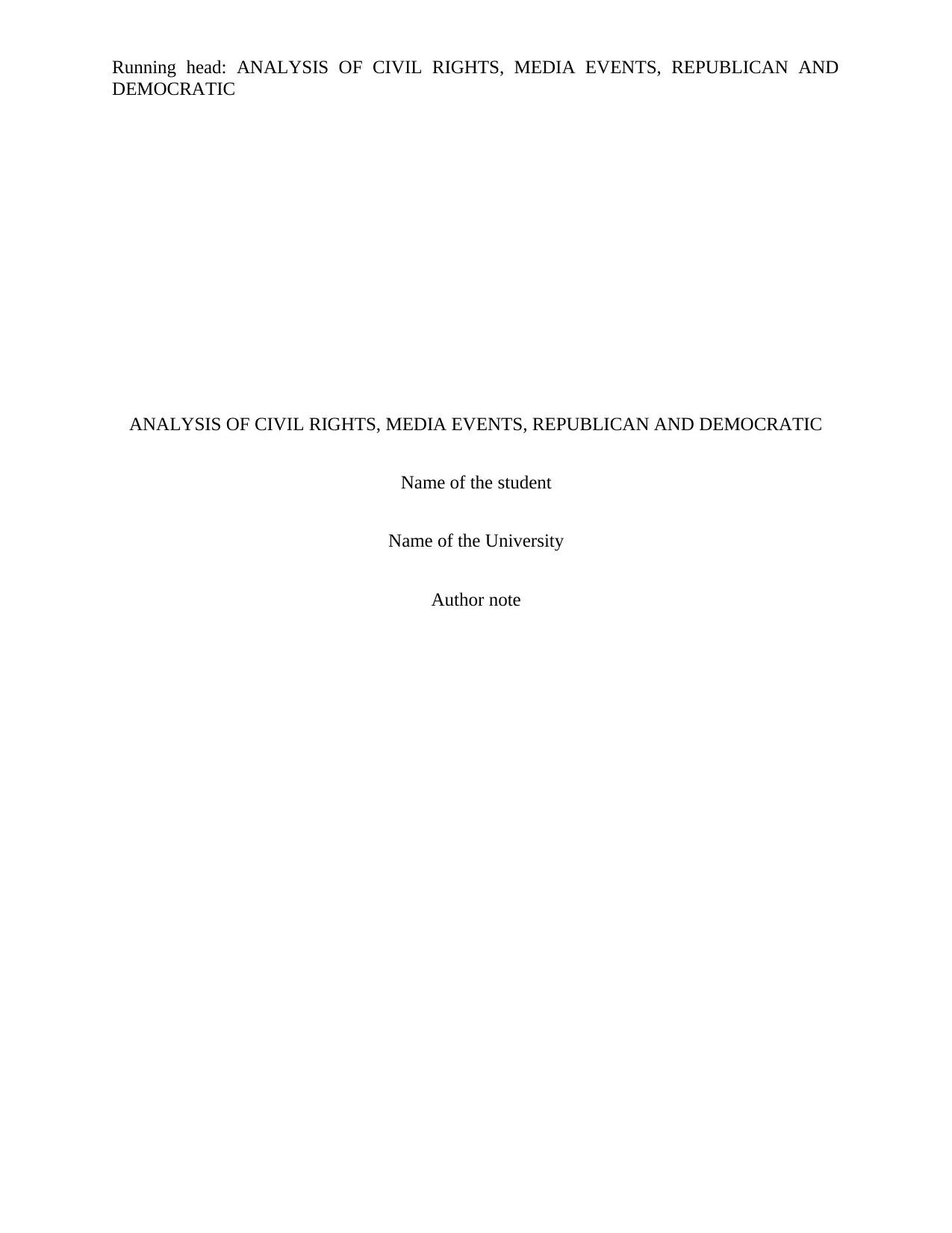
Running head: ANALYSIS OF CIVIL RIGHTS, MEDIA EVENTS, REPUBLICAN AND
DEMOCRATIC
ANALYSIS OF CIVIL RIGHTS, MEDIA EVENTS, REPUBLICAN AND DEMOCRATIC
Name of the student
Name of the University
Author note
DEMOCRATIC
ANALYSIS OF CIVIL RIGHTS, MEDIA EVENTS, REPUBLICAN AND DEMOCRATIC
Name of the student
Name of the University
Author note
Paraphrase This Document
Need a fresh take? Get an instant paraphrase of this document with our AI Paraphraser
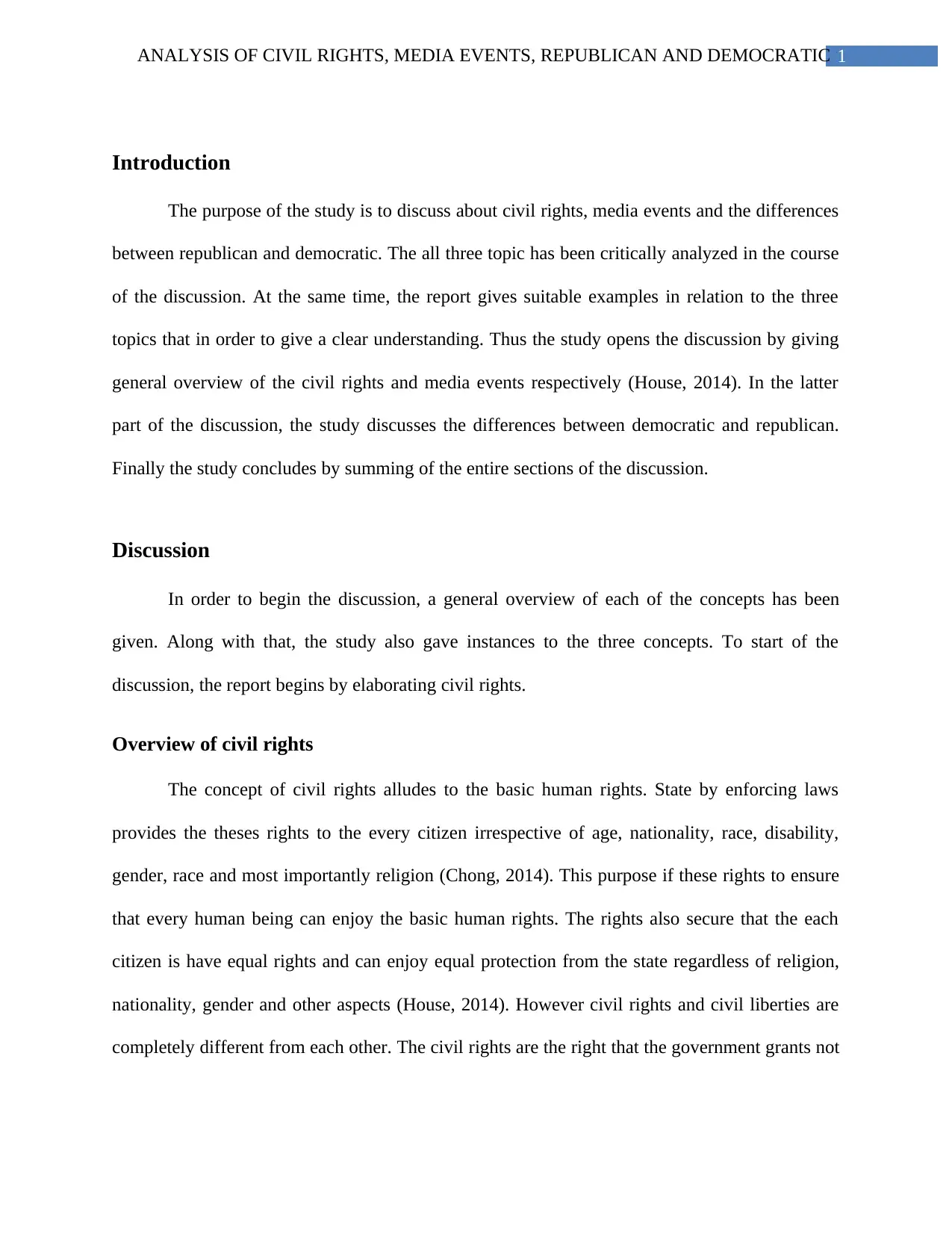
1ANALYSIS OF CIVIL RIGHTS, MEDIA EVENTS, REPUBLICAN AND DEMOCRATIC
Introduction
The purpose of the study is to discuss about civil rights, media events and the differences
between republican and democratic. The all three topic has been critically analyzed in the course
of the discussion. At the same time, the report gives suitable examples in relation to the three
topics that in order to give a clear understanding. Thus the study opens the discussion by giving
general overview of the civil rights and media events respectively (House, 2014). In the latter
part of the discussion, the study discusses the differences between democratic and republican.
Finally the study concludes by summing of the entire sections of the discussion.
Discussion
In order to begin the discussion, a general overview of each of the concepts has been
given. Along with that, the study also gave instances to the three concepts. To start of the
discussion, the report begins by elaborating civil rights.
Overview of civil rights
The concept of civil rights alludes to the basic human rights. State by enforcing laws
provides the theses rights to the every citizen irrespective of age, nationality, race, disability,
gender, race and most importantly religion (Chong, 2014). This purpose if these rights to ensure
that every human being can enjoy the basic human rights. The rights also secure that the each
citizen is have equal rights and can enjoy equal protection from the state regardless of religion,
nationality, gender and other aspects (House, 2014). However civil rights and civil liberties are
completely different from each other. The civil rights are the right that the government grants not
Introduction
The purpose of the study is to discuss about civil rights, media events and the differences
between republican and democratic. The all three topic has been critically analyzed in the course
of the discussion. At the same time, the report gives suitable examples in relation to the three
topics that in order to give a clear understanding. Thus the study opens the discussion by giving
general overview of the civil rights and media events respectively (House, 2014). In the latter
part of the discussion, the study discusses the differences between democratic and republican.
Finally the study concludes by summing of the entire sections of the discussion.
Discussion
In order to begin the discussion, a general overview of each of the concepts has been
given. Along with that, the study also gave instances to the three concepts. To start of the
discussion, the report begins by elaborating civil rights.
Overview of civil rights
The concept of civil rights alludes to the basic human rights. State by enforcing laws
provides the theses rights to the every citizen irrespective of age, nationality, race, disability,
gender, race and most importantly religion (Chong, 2014). This purpose if these rights to ensure
that every human being can enjoy the basic human rights. The rights also secure that the each
citizen is have equal rights and can enjoy equal protection from the state regardless of religion,
nationality, gender and other aspects (House, 2014). However civil rights and civil liberties are
completely different from each other. The civil rights are the right that the government grants not
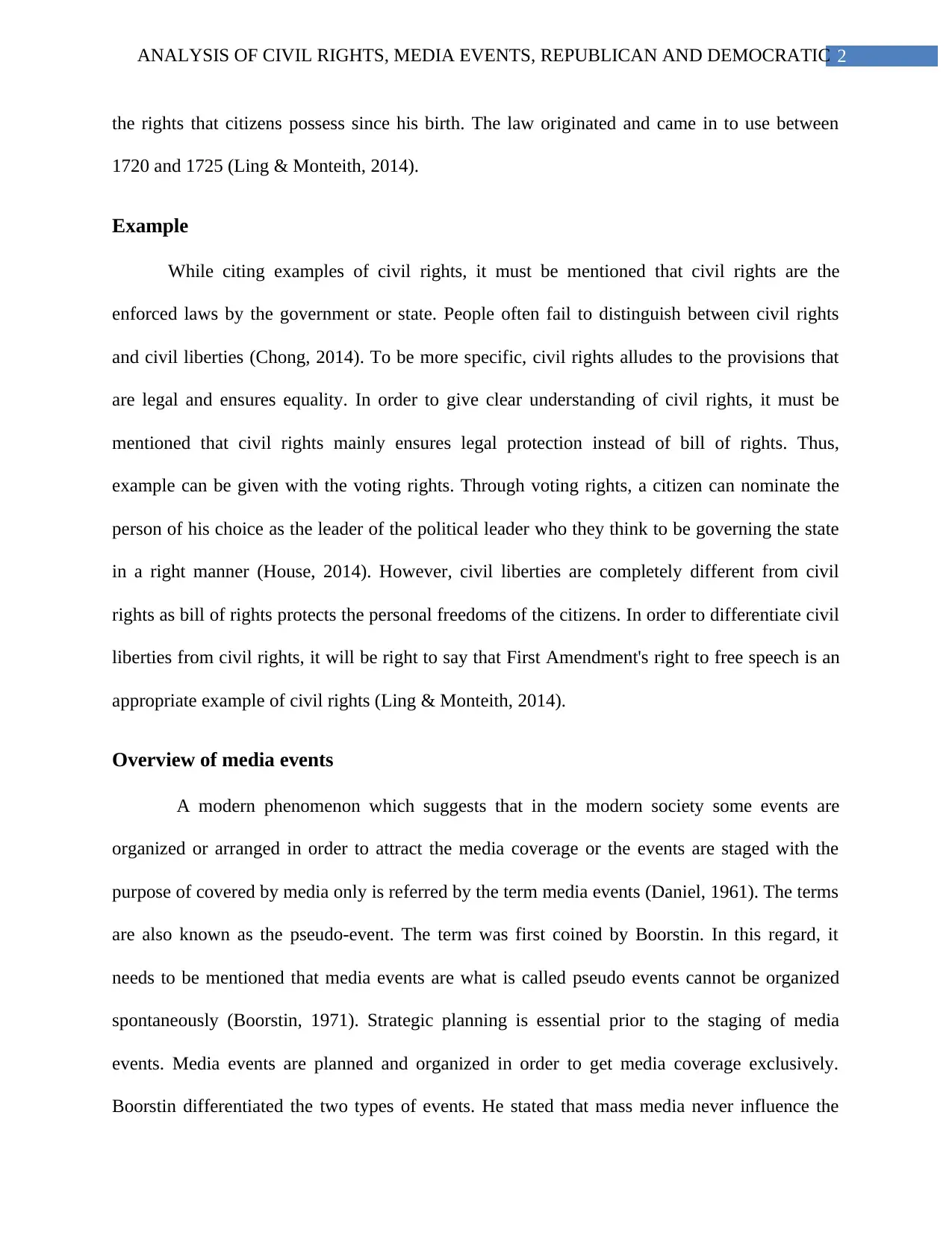
2ANALYSIS OF CIVIL RIGHTS, MEDIA EVENTS, REPUBLICAN AND DEMOCRATIC
the rights that citizens possess since his birth. The law originated and came in to use between
1720 and 1725 (Ling & Monteith, 2014).
Example
While citing examples of civil rights, it must be mentioned that civil rights are the
enforced laws by the government or state. People often fail to distinguish between civil rights
and civil liberties (Chong, 2014). To be more specific, civil rights alludes to the provisions that
are legal and ensures equality. In order to give clear understanding of civil rights, it must be
mentioned that civil rights mainly ensures legal protection instead of bill of rights. Thus,
example can be given with the voting rights. Through voting rights, a citizen can nominate the
person of his choice as the leader of the political leader who they think to be governing the state
in a right manner (House, 2014). However, civil liberties are completely different from civil
rights as bill of rights protects the personal freedoms of the citizens. In order to differentiate civil
liberties from civil rights, it will be right to say that First Amendment's right to free speech is an
appropriate example of civil rights (Ling & Monteith, 2014).
Overview of media events
A modern phenomenon which suggests that in the modern society some events are
organized or arranged in order to attract the media coverage or the events are staged with the
purpose of covered by media only is referred by the term media events (Daniel, 1961). The terms
are also known as the pseudo-event. The term was first coined by Boorstin. In this regard, it
needs to be mentioned that media events are what is called pseudo events cannot be organized
spontaneously (Boorstin, 1971). Strategic planning is essential prior to the staging of media
events. Media events are planned and organized in order to get media coverage exclusively.
Boorstin differentiated the two types of events. He stated that mass media never influence the
the rights that citizens possess since his birth. The law originated and came in to use between
1720 and 1725 (Ling & Monteith, 2014).
Example
While citing examples of civil rights, it must be mentioned that civil rights are the
enforced laws by the government or state. People often fail to distinguish between civil rights
and civil liberties (Chong, 2014). To be more specific, civil rights alludes to the provisions that
are legal and ensures equality. In order to give clear understanding of civil rights, it must be
mentioned that civil rights mainly ensures legal protection instead of bill of rights. Thus,
example can be given with the voting rights. Through voting rights, a citizen can nominate the
person of his choice as the leader of the political leader who they think to be governing the state
in a right manner (House, 2014). However, civil liberties are completely different from civil
rights as bill of rights protects the personal freedoms of the citizens. In order to differentiate civil
liberties from civil rights, it will be right to say that First Amendment's right to free speech is an
appropriate example of civil rights (Ling & Monteith, 2014).
Overview of media events
A modern phenomenon which suggests that in the modern society some events are
organized or arranged in order to attract the media coverage or the events are staged with the
purpose of covered by media only is referred by the term media events (Daniel, 1961). The terms
are also known as the pseudo-event. The term was first coined by Boorstin. In this regard, it
needs to be mentioned that media events are what is called pseudo events cannot be organized
spontaneously (Boorstin, 1971). Strategic planning is essential prior to the staging of media
events. Media events are planned and organized in order to get media coverage exclusively.
Boorstin differentiated the two types of events. He stated that mass media never influence the
⊘ This is a preview!⊘
Do you want full access?
Subscribe today to unlock all pages.

Trusted by 1+ million students worldwide
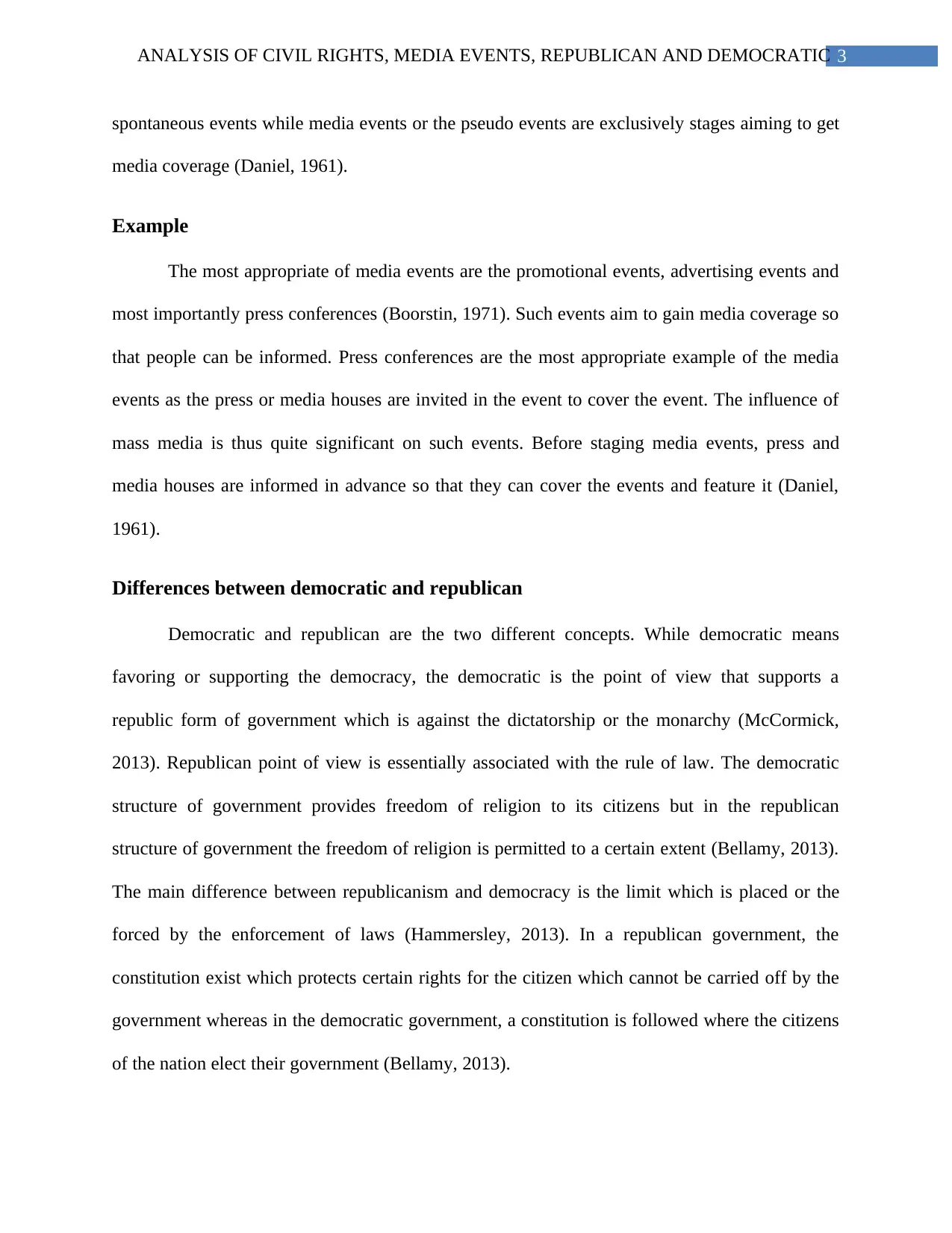
3ANALYSIS OF CIVIL RIGHTS, MEDIA EVENTS, REPUBLICAN AND DEMOCRATIC
spontaneous events while media events or the pseudo events are exclusively stages aiming to get
media coverage (Daniel, 1961).
Example
The most appropriate of media events are the promotional events, advertising events and
most importantly press conferences (Boorstin, 1971). Such events aim to gain media coverage so
that people can be informed. Press conferences are the most appropriate example of the media
events as the press or media houses are invited in the event to cover the event. The influence of
mass media is thus quite significant on such events. Before staging media events, press and
media houses are informed in advance so that they can cover the events and feature it (Daniel,
1961).
Differences between democratic and republican
Democratic and republican are the two different concepts. While democratic means
favoring or supporting the democracy, the democratic is the point of view that supports a
republic form of government which is against the dictatorship or the monarchy (McCormick,
2013). Republican point of view is essentially associated with the rule of law. The democratic
structure of government provides freedom of religion to its citizens but in the republican
structure of government the freedom of religion is permitted to a certain extent (Bellamy, 2013).
The main difference between republicanism and democracy is the limit which is placed or the
forced by the enforcement of laws (Hammersley, 2013). In a republican government, the
constitution exist which protects certain rights for the citizen which cannot be carried off by the
government whereas in the democratic government, a constitution is followed where the citizens
of the nation elect their government (Bellamy, 2013).
spontaneous events while media events or the pseudo events are exclusively stages aiming to get
media coverage (Daniel, 1961).
Example
The most appropriate of media events are the promotional events, advertising events and
most importantly press conferences (Boorstin, 1971). Such events aim to gain media coverage so
that people can be informed. Press conferences are the most appropriate example of the media
events as the press or media houses are invited in the event to cover the event. The influence of
mass media is thus quite significant on such events. Before staging media events, press and
media houses are informed in advance so that they can cover the events and feature it (Daniel,
1961).
Differences between democratic and republican
Democratic and republican are the two different concepts. While democratic means
favoring or supporting the democracy, the democratic is the point of view that supports a
republic form of government which is against the dictatorship or the monarchy (McCormick,
2013). Republican point of view is essentially associated with the rule of law. The democratic
structure of government provides freedom of religion to its citizens but in the republican
structure of government the freedom of religion is permitted to a certain extent (Bellamy, 2013).
The main difference between republicanism and democracy is the limit which is placed or the
forced by the enforcement of laws (Hammersley, 2013). In a republican government, the
constitution exist which protects certain rights for the citizen which cannot be carried off by the
government whereas in the democratic government, a constitution is followed where the citizens
of the nation elect their government (Bellamy, 2013).
Paraphrase This Document
Need a fresh take? Get an instant paraphrase of this document with our AI Paraphraser
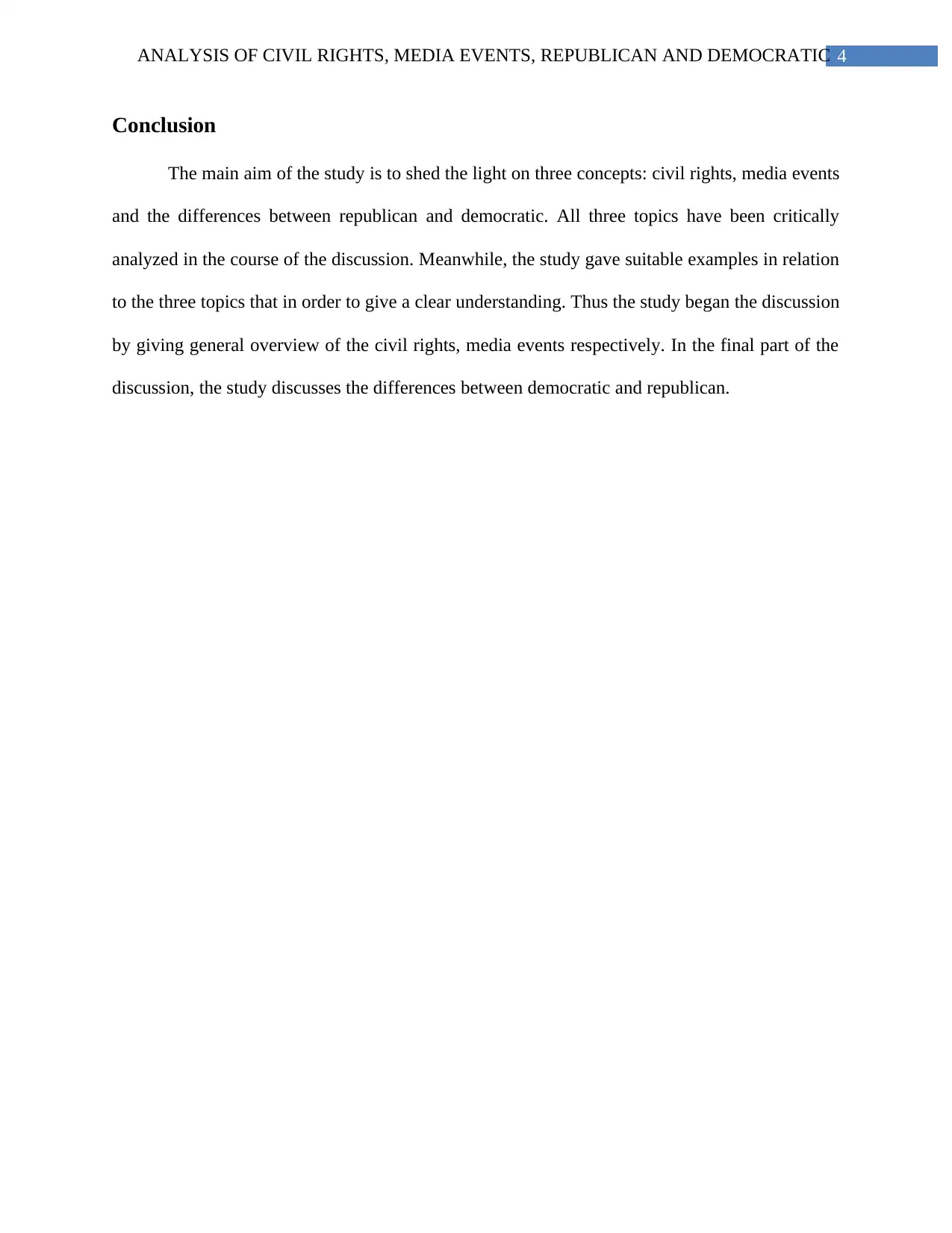
4ANALYSIS OF CIVIL RIGHTS, MEDIA EVENTS, REPUBLICAN AND DEMOCRATIC
Conclusion
The main aim of the study is to shed the light on three concepts: civil rights, media events
and the differences between republican and democratic. All three topics have been critically
analyzed in the course of the discussion. Meanwhile, the study gave suitable examples in relation
to the three topics that in order to give a clear understanding. Thus the study began the discussion
by giving general overview of the civil rights, media events respectively. In the final part of the
discussion, the study discusses the differences between democratic and republican.
Conclusion
The main aim of the study is to shed the light on three concepts: civil rights, media events
and the differences between republican and democratic. All three topics have been critically
analyzed in the course of the discussion. Meanwhile, the study gave suitable examples in relation
to the three topics that in order to give a clear understanding. Thus the study began the discussion
by giving general overview of the civil rights, media events respectively. In the final part of the
discussion, the study discusses the differences between democratic and republican.
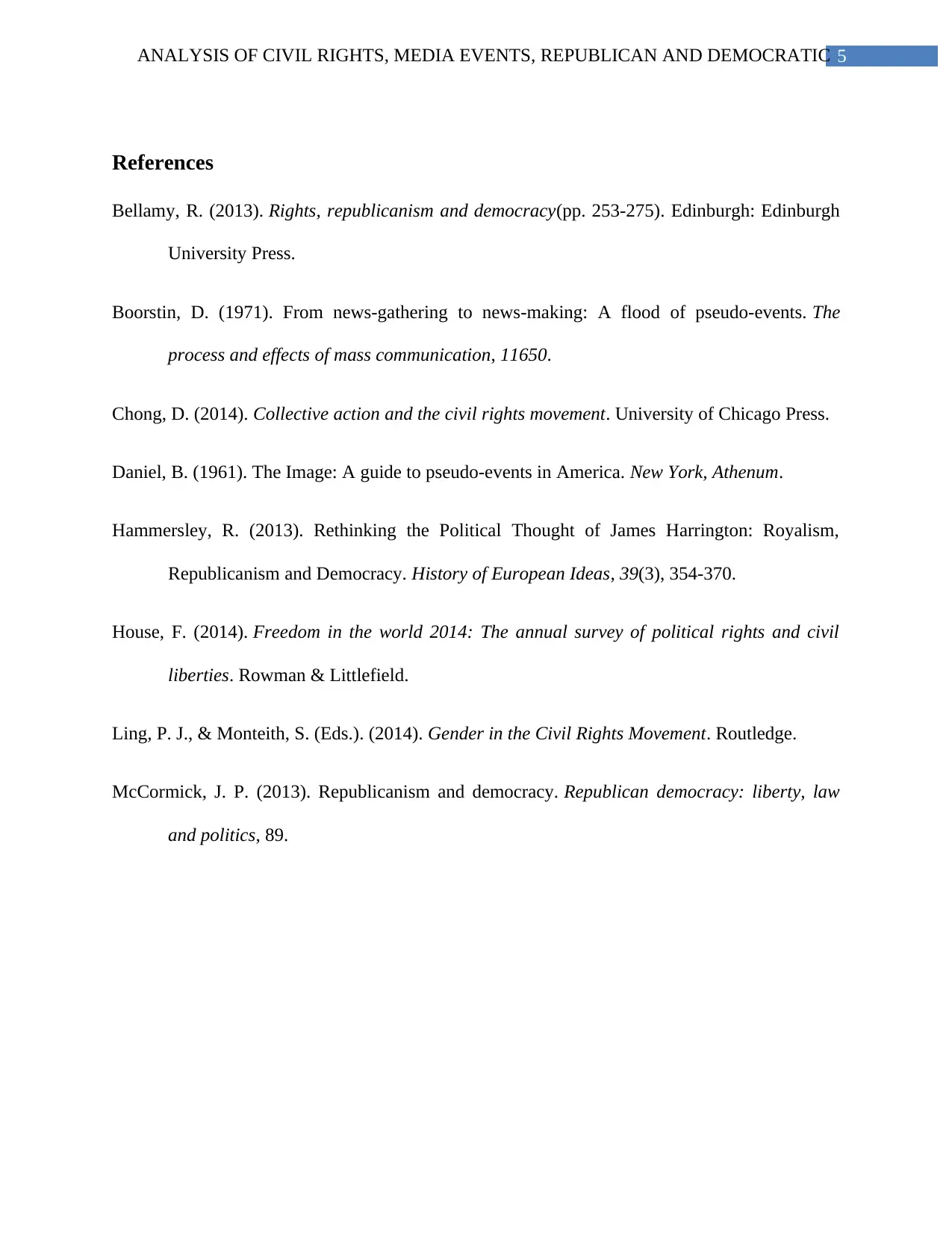
5ANALYSIS OF CIVIL RIGHTS, MEDIA EVENTS, REPUBLICAN AND DEMOCRATIC
References
Bellamy, R. (2013). Rights, republicanism and democracy(pp. 253-275). Edinburgh: Edinburgh
University Press.
Boorstin, D. (1971). From news-gathering to news-making: A flood of pseudo-events. The
process and effects of mass communication, 11650.
Chong, D. (2014). Collective action and the civil rights movement. University of Chicago Press.
Daniel, B. (1961). The Image: A guide to pseudo-events in America. New York, Athenum.
Hammersley, R. (2013). Rethinking the Political Thought of James Harrington: Royalism,
Republicanism and Democracy. History of European Ideas, 39(3), 354-370.
House, F. (2014). Freedom in the world 2014: The annual survey of political rights and civil
liberties. Rowman & Littlefield.
Ling, P. J., & Monteith, S. (Eds.). (2014). Gender in the Civil Rights Movement. Routledge.
McCormick, J. P. (2013). Republicanism and democracy. Republican democracy: liberty, law
and politics, 89.
References
Bellamy, R. (2013). Rights, republicanism and democracy(pp. 253-275). Edinburgh: Edinburgh
University Press.
Boorstin, D. (1971). From news-gathering to news-making: A flood of pseudo-events. The
process and effects of mass communication, 11650.
Chong, D. (2014). Collective action and the civil rights movement. University of Chicago Press.
Daniel, B. (1961). The Image: A guide to pseudo-events in America. New York, Athenum.
Hammersley, R. (2013). Rethinking the Political Thought of James Harrington: Royalism,
Republicanism and Democracy. History of European Ideas, 39(3), 354-370.
House, F. (2014). Freedom in the world 2014: The annual survey of political rights and civil
liberties. Rowman & Littlefield.
Ling, P. J., & Monteith, S. (Eds.). (2014). Gender in the Civil Rights Movement. Routledge.
McCormick, J. P. (2013). Republicanism and democracy. Republican democracy: liberty, law
and politics, 89.
⊘ This is a preview!⊘
Do you want full access?
Subscribe today to unlock all pages.

Trusted by 1+ million students worldwide
1 out of 6
Your All-in-One AI-Powered Toolkit for Academic Success.
+13062052269
info@desklib.com
Available 24*7 on WhatsApp / Email
![[object Object]](/_next/static/media/star-bottom.7253800d.svg)
Unlock your academic potential
Copyright © 2020–2025 A2Z Services. All Rights Reserved. Developed and managed by ZUCOL.

